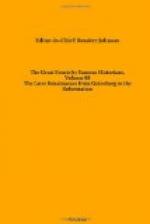[Footnote 1: The great Hungarian leader, who long fought against the Turks, and signally defeated them at Belgrad in 1456.—ED.]
WARS OF THE ROSES
DEATH OF RICHARD III AT BOSWORTH
A.D. 1455-1485
DAVID HUME
Historians themselves declare that no part of English history since the Norman Conquest is so obscure and uncertain as that of the Wars of the Roses. “All we can distinguish with certainty through the deep cloud which covers that period is a scene of horror and bloodshed, savage manners, arbitrary executions and treacheries, dishonorable conduct in all parties.” These brutal aspects of that horrid drama of history, running through more than the course of a full generation, are depicted for the mimic stage by Shakespeare, in Henry VI and Richard III, with a vividness that brings before us the ghastly realities of the historic theatre itself, and with such realization of the rude forces at work as calls for all the poet’s refining art to make their representation tolerable to modern spectators.
But the historians, while consciously failing to discover the hidden motives of intrigue and treachery which throughout actuated the parties to this fearful struggle of Englishmen with Englishmen, have nevertheless recorded for us its main outlines and leading episodes with sufficient clearness. We are enabled to see England as she was in that great transition of her “making”—in the throes of civil strife, again to be endured two centuries later—through which she must pass before she could become a “land of settled government.”




